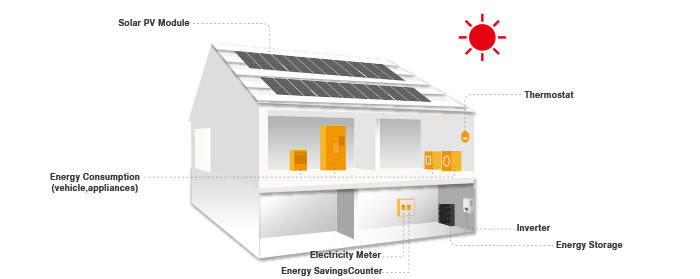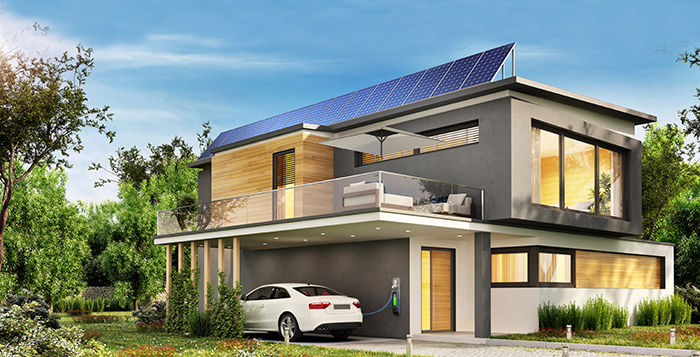Smart home solar energy storage systems have become more common over the past few years. Green power can be given to the family day or night, and with solar power, you don't have to worry about high tiered energy prices. This saves you money on your electricity bill and makes sure that everyone has a good quality of life.
During the day, the home PV energy storage system collects solar power and stores it automatically so that it can be used by the load at night. If the power goes out suddenly, the system can quickly switch to a backup power source to make sure that all of the lights, appliances, and other equipment always work as they should. The battery pack in the home energy storage system can be charged on its own when the power isn't being used. This way, it can be used when the power goes out or when power is most needed. The home energy storage device can be used as a backup power source in case of a disaster. It can also balance the load of power use, which saves the family money on their power bills. A smart home PV energy storage system works like a small energy storage power station and is not affected by the stress of the power grid in cities.

Question mark for professionals?
What kinds of parts does such a powerful home PV energy storage system have, and what does it depend on to work? What types of home PV energy storage solutions are there? Why is it important to pick the right home PV energy storage system?
CEM Know-How "Seconds"
What is a PV energy storage system for a home?
A home photovoltaic energy storage system is made up of a solar photovoltaic conversion system and an energy storage equipment system. It can store electricity generated by the sun. With this kind of setup, people can make power during the day and store the extra to use at night or when there isn't much light.
Sorting home PV energy storage systems into groups
At the moment, there are two types of home energy storage systems: those that are tied to the grid and those that are not.
Grid-connected energy storage solution for the home
Solar panels, grid-connected inverters, a battery management system (BMS), and AC loads make up its five major parts. PV panels and an energy storage system work together to power the device. When the utility power is on, both the PV grid-connected system and the utility power power the load. When the utility power goes out, both the PV grid-connected system and the energy storage system power the load together. There are three ways that the grid-connected home energy storage system can work: Mode 1: PV stores energy and sends the extra power to the Internet; Mode 2: PV stores energy and helps the user with some of their electricity needs; and Mode 3: PV only stores some of the energy.
Off-grid method for storing energy at home
The PV inverter can work because it is separate from the grid and doesn't need to be linked to it. This means that the whole system doesn't need a grid-connected converter. The off-grid home energy storage system has three different working modes. In mode 1, the PV provides energy storage and user electricity on sunny days. In mode 2, the PV and storage battery provide user electricity on cloudy days. And in mode 3, the storage battery provides user electricity on dark and rainy days.
An inverter is like the brain and heart of a home energy storage system. It can't be separated from the system, no matter if it's tied to the grid or not.
Is there a word for this?
An inverter is a common part of power systems. It can change DC power (from batteries or reserve batteries) into AC power (220v50HZ sine or square wave). To put it simply, an inverter is a machine that changes direct current (DC) into alternating current (AC). There is a converter bridge, control logic, and a filter circuit in it. Rectifier diodes and thyristors are two common parts. Most computers and home gadgets have rectifiers (DC to AC) built into their power supplies. These are called inverters.

What makes transformers such an important part of the system?
AC transmission works better than DC transmission and is used to send energy to many places. You can find out how much power is lost by the wire's transmitted current by using the equation P=I2R, which stands for "power = square of the current resistance." To lower the energy loss, you need to either lower the wire's transmitted current or its resistance. It is hard to lower the resistance of the transmission lines (like copper wires) because it costs a lot of money and takes a lot of scientific know-how. This means that the only effective way is to lower the transmitted power. Power = Current x Voltage, or more specifically, effective power = IUcosφ. To save energy, the current in the lines can be dropped by changing direct current to alternating current and raising the grid's voltage.
In the same way, solar photovoltaic power production uses photovoltaic panels to make DC energy. However, many loads need AC energy. There are some problems with DC power source systems. It's not easy to change the voltage, and the loads that can be used are restricted. All loads, except for certain power loads, need to use inverters to change DC power to AC power. The photovoltaic converter is the most important part of a solar photovoltaic power system. It turns DC power from the photovoltaic module into AC power, which is then sent to a load or the power source and protects the power electronics. Power modules, control circuit boards, circuit breakers, filters, reactors, transformers, contactors, cabinets, and other parts make up a PV inverter. Pre-processing of electronic parts, machine assembly, testing, machine packing, and other steps make up the production process. The growth of these steps relies on the progress made in power electronics technology, semiconductor device technology, and modern control technology.
Different Types of Inverters
Inverter can be roughly broken down into these three groups:
1. Inverter connected to the grid
As well as changing DC to AC, a grid-connected inverter can sync its output AC with the frequency and phase of the utility power. This means that the output AC can be fed back into the utility power. In other words, a grid-connected inverter can connect to the utility line in a synchronous way. This inverter can send power that isn't being used to the grid without batteries, and its input circuit can be made to work with MTTP technology.
2. Inverters that don't need to be connected to the grid
Off-grid inverters, which are usually attached to solar panels, small wind turbines, or other DC power sources, change DC power into AC power that a home can use. They can also power loads with energy from the grid and batteries. It's called "off-grid" because it doesn't connect to the power grid and doesn't need an outside power source.
Off-grid inverters are first battery-powered systems that make it possible for microgrids to work in specific areas. An off-grid inverter can store energy and change it into other forms. It has current inputs, DC inputs, fast charge inputs, high-capacity DC outputs, and fast AC outputs. It uses control software to change the input and output conditions so that sources like solar panels or small wind mills work as efficiently as possible. It also uses a pure sine wave output to improve the quality of the energy.
The off-grid inverter Batteries are necessary for off-grid solar systems because they store energy that can be used when the power goes out or when there is no electricity. Off-grid inverters also help you depend less on the main grid, which can cause power outages, blackouts, and other problems that companies can't fix.
An off-grid inverter with a solar charge controller also has an internal PWM or MPPT solar controller that lets the user connect the PV inputs to the solar inverter and see the PV status on the display of the solar inverter. This makes it easy to set up and check the system. Off-grid inverters in backup engines and batteries are self-testing to make sure that the power quality is stable and full. While low-wattage ones are used to power home appliances, high-wattage ones are mostly used to power business and private projects.
3. Hybrid Inverter
There are two main types of hybrid inverters: one is an off-grid inverter with a solar charge controller built in, and the other is an on-grid and off-grid inverter that can be used for both grid-connected and off-grid photovoltaic systems and whose batteries can be set up in a variety of ways.
What the transformer does in general
1. Functions for automatic running and shutting down
As the day goes on and the sun's angle slowly rises, so does the strength of the sun's rays. The PV system can take in more solar energy, and when it hits the output power level needed for the inverter to work, it can start running on its own. It will stop working and go into sleep mode when the grid-connected/storage inverter's output is 0 or very close to 0. This happens when the PV system's output power goes down.
2. Function of anti-islanding effect
The process of grid-connected photovoltaic power generation, the photovoltaic power generation system, and the power system grid operation. When the public power grid goes down or behaves strangely, the islanding effect happens if the photovoltaic power generation system can't stop working in time or gets disconnected from the power system but still has power. It's bad for both the PV system and the power source when there are islands of power.
Grid-connected/energy storage inverter has an internal anti-islanding protection circuit that can intelligently detect the grid in real time and include voltage, frequency, and other information. If abnormalities are found in the public grid, the inverter can use different measured values at the right time to cut off the current, stop the output, and report faults.
3. Control feature for maximum power point tracking
A grid-connected or storage inverter's most important technology is its maximum power point tracking control function (MPPT function). This function lets the inverter find and watch the highest output power of its parts in real time.
There are many things that can change a PV system's output power, and it's not always possible to keep it at its stated best output power.
The grid-connected/storage inverter's MPPT function can track the highest power output of each component in real time. It can then intelligently adjust the system's working point voltage (or current) to bring it closer to the peak power point, which will maximise the power generated by the PV system and make sure it can work continuously and efficiently.
4. Intelligent feature for keeping an eye on strings
Based on the first MPPT tracking, the grid-connected/energy storage inverter has already completed the smart string detection function. String detection correctly checks the voltage and current to each branch string, unlike MPPT tracking. This lets the user see the real-time operation data of each string.
The energy storage systems that people want right now are the BMS battery management system, the PV grid-connected inverter, and the energy storage inverter. In order to meet these needs for home energy storage equipment and to combine the safety isolation features of each PV system unit circuit, Huashengchang has released a full set of home PV energy storage systems. These systems mostly consist of grid-connected inverters and hybrid inverters.







